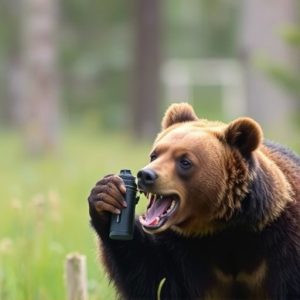Navigating Alaska’s Bear Country: Pepper Spray, Gear, & Safety Tips
In Alaska's wilderness, bear encounters are common, necessitating hikers to carry appropriate g…….
In Alaska's wilderness, bear encounters are common, necessitating hikers to carry appropriate gear like bear pepper spray, adhering to TSA restrictions on liquids. Black bears are generally less aggressive but unexpected interactions require precautions. Understanding these rules ensures safe hikes and access to protective gear, with the spray being a crucial component of a well-rounded hiking kit. Verifying restrictions on the TSA website before travel is vital to avoid disruptions during security checks. Additionally, adopting a multi-layered defense strategy, including noise, clothing, deterrents, tools, and lighting, enhances safety in bear-inhabited areas, while group hiking and food security further minimize risks.
Alaska’s rugged landscapes attract adventurers, but they also home to bears. Understanding bear encounters and equipping yourself with the right gear is crucial for a safe hike. This guide delves into the risks of bear interactions in Alaska, highlighting the importance of bear pepper spray as a primary defense. We explore TSA restrictions on carry-on items, offering insights for hikers to navigate these rules effectively. Additionally, we provide tips on selecting suitable bear repellent gear and essential precautions for hiking in bear country beyond just carrying pepper spray.
- Understanding Bear Encounters in Alaska: Risks and Precautions
- The Role of Pepper Spray in Bear Repellent Gear
- TSA Restrictions on Bear Pepper Spray: What Hikers Need to Know
- Choosing the Right Bear Repellent Hiking Gear for Alaska
- Tips for Safe Hiking in Bear Country: Beyond Just Pepper Spray
Understanding Bear Encounters in Alaska: Risks and Precautions
In Alaska, bear encounters while hiking are not uncommon, and understanding the risks is essential for outdoor enthusiasts. While black bears are generally less aggressive than their grizzly counterparts, unexpected interactions can occur. Bears are attracted to food sources, so hikers must take precautions to avoid becoming a target. Carrying the right gear, such as a reliable bear repellent like pepper spray, is crucial.
Bear pepper spray has become a popular choice for hikers in Alaska due to its effectiveness and ease of use. However, it’s important to note that there are TSA restrictions on liquids, gels, and aerosols carried onto airplanes, including bear spray. Hikers should check these regulations before planning their trip. Understanding these risks and following proper precautions can ensure a safe and enjoyable hiking experience in Alaska’s beautiful yet unpredictable wilderness.
The Role of Pepper Spray in Bear Repellent Gear
Bear pepper spray is a crucial component of any comprehensive hiking gear, especially in regions where bear encounters are a reality. It serves as a powerful deterrent when navigating through forests and wilderness areas known for their bustling wildlife, including bears. The primary function of this repellent is to create a temporary but intense irritation, causing the bear to flee the area swiftly.
When it comes to hiking gear, understanding TSA restrictions on bear pepper spray is essential. Travelers heading to areas with high bear activity need to be mindful of these regulations to ensure they can access their protective gear during their journey. The TSA allows carrying small containers of pepper spray (typically 3.4 ounces or less) in carry-on luggage but has specific guidelines regarding their packaging and labeling. Knowing these rules ensures hikers can stay safe while adhering to travel restrictions, making it a vital part of any well-prepared hiking kit.
TSA Restrictions on Bear Pepper Spray: What Hikers Need to Know
When preparing for a hike in Alaska, especially in areas known for bear activity, it’s crucial to pack essential gear, including bear pepper spray. However, hikers often wonder about the TSA restrictions on carrying bear pepper spray through airport security. The Transportation Security Administration (TSA) has specific guidelines regarding bear pepper spray and other similar items.
Bear pepper spray is generally allowed as long as it meets the following criteria: it’s in its original container, the label indicates the contents, and the total volume doesn’t exceed 3.4 ounces (100 milliliters). Additionally, ensure that it’s not in a liquid, gel, or aerosol form that exceeds 3.4 ounces. Always check the TSA website for any updates to these restrictions before your trip to avoid inconvenience during security checks.
Choosing the Right Bear Repellent Hiking Gear for Alaska
When planning a hike in Alaska, selecting the appropriate bear repellent hiking gear is paramount for your safety. The state’s diverse landscapes and abundant wildlife, including bears, demand preparedness. One of the most effective tools is bear pepper spray, designed to deter aggressive bears at close range. However, it’s crucial to understand the TSA restrictions on liquids when packing your spray, ensuring you meet size and quantity guidelines.
Choosing gear that complies with these regulations is essential for hassle-free travel. Look for canisters that are specifically labeled for air travel and meet the 3.4-ounce (100ml) limit per container. This ensures your bear pepper spray is readily available when needed, without creating additional baggage headaches. Remember, in Alaska’s vast wilderness, such precautions aren’t just recommended—they’re often a matter of survival.
Tips for Safe Hiking in Bear Country: Beyond Just Pepper Spray
When hiking in areas known for bear presence, it’s crucial to go beyond just carrying bear pepper spray, a staple often subject to TSA restrictions. While effective, spray can be limited by range and wind conditions, so layering your defense is key. Start with loud, distinctive noises that can startle bears, like shouting or banging pots together. Wearing bell-adorned clothing or using bear deterrents on your backpack can also help make you more visible and less of an attractive target.
Ensure your hiking gear includes a sturdy stick for physical defense if needed, as well as a reliable flashlight to illuminate unexpected encounters. Knowing how to react—staying calm, making yourself appear larger, and speaking firmly—can significantly reduce risk. Always hike in groups, make noise regularly to avoid surprising bears, and store food securely far from your camp or trailside to minimize attractants.
When hiking in Alaska’s diverse landscapes, understanding bear encounters and arming yourself with the right gear, like effective bear pepper spray, is paramount. Being aware of TSA restrictions on bear repellent items ensures hikers can stay safe without compromising their travel plans. By combining knowledge, suitable gear, and responsible practices, adventurers can enjoy a memorable experience while minimizing risks associated with bears in Alaska’s wild environments.


